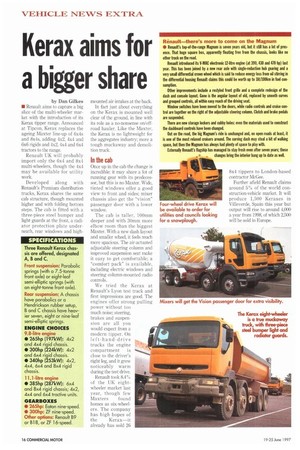Kerax aims for a bigger share
Page 18

If you've noticed an error in this article please click here to report it so we can fix it.
by Dan Gilkes • Renault aims to capture a big slice of the multi-wheeler market with the introduction of its Kerax tipper range. Announced at Tipcon, Kerax replaces the ageing Maxter line-up of 6x4s and 8x4s, adding 4x2, 4x4 and 6x6 rigids and 4x2, 4x4 and 6x4 tractors to the range.
Renault UK will probably import only the 6x4 and 8x4 multi-wheelers, though the 4x4 may be available for utility work.
Developed along with Renault's Premium distribution trucks, Kerax shares the same cab structure, though mounted higher and with folding bottom steps. The cab is fitted with a three-piece steel bumper and light guards at the front, a radiator protection plate underneath, rear windows and high mounted air intakes at the back.
In fact just about everything on the Kerax is mounted well clear of the ground, in line with its role as a no-nonsense on/offroad hauler. Like the Maxter, the Kerax is no lightweight for the aggregates industry; more a tough muckaway and demolition truck.
In the cab
Once up in the cab the change is incredible: it may share a lot of running gear with its predecessor, but this is no Maxter. Wide, tinted windows offer a good view to front and sides; mixer chassis also get the "vision" passenger door with a lower window.
The cab is taller, 100mm deeper and with 30mm more elbow room than the biggest Maxter. With a new dash layout and smaller wheel, it feels much more spacious. The air-actuated adjustable steering column and improved suspension seat make it easy to get comfortable: a "comfort pack" is available, including electric windows and steering column-mounted radio controls.
We tried the Kerax at Renault's Lyon test track and first impressions are good. The engines offer strong pulling power without too much noise; steering, brakes and suspension are all you would expect from a modern tipper. On left-hand-drive trucks the engine
compartment is close to the driver's right leg, and it grew noticeably warm during the test drive.
Renault took 8.4% of the UK eightwheeler market last year, though few Max te rs found homes as six-wheelers. The company has high hopes of the Kerax—it already has sold 26
8x4 tippers to London-based contractor McGee.
Further afield Renault claims around 5% of the world construction-vehicle market. It will produce 1,500 Keraxes in Villeverde, Spain this year but output will rise to around 4,000 a year from 1998, of which 2,500 will be sold in Europe.
SPECIFICATIONS Three Renault Kerax chassis are offered, designated A, B and C.
Front suspension: Parabolic springs (with a 7.5-tonne front axle) or eight-leaf semi-elliptic springs (with an eight-tonne front oxle).
Rear suspension: A chassis have parabolics or a Hendrickson rubber setup, B and C chassis have heavier seven, eight or nine-leaf semi-elliptic springs.
• NGINE CHOICES 9.8-litre engine
• 265hp (197kW): 4x2 and 4x4 rigid chassis.
• 300hp (224kW): 4x2 and 6x4 rigid chassis.
• 340hp (253kW): 4x2, 4x4, 6x4 and 8x4 rigid chassis.
11.1-litre engine
• 385hp (287kW): 6x4 and 8x4 rigid chassis; 4x2, 4x4 and 6x4 tractive units.
GEARBOXES
• 265hp: Eaton nine-speed. • 300hp: ZF nine-speed. Other options: Renault B9 or B18, or ZF 16-speed.
Renault—there's more to come on the Magnum
• Renault's top-of-the-range Magnum is seven years old, but it still has a lot of presence. That huge square box, apparently floating free from the chassis, looks like no other truck on the road.
Renault introduced its V-MAC electronic 12-litre engine (at 390, 430 and 470 hp) last year. This has been joined by a new rear axle with single-reduction hub gearing and a very small differential crown wheel which is said to reduce energy loss from oil stirring in the differential housing Renault claims this could be worth up to llit/100km in fuel consumption.
Other improvements include a restyled front grille and a complete redesign of the dash and console layout. Cone is the angular layout of old, replaced by smooth curves and grouped controls, all within easy reach of the driving seat.
Window switches have been moved to the doors, while radio controls and cruise control are together on the right of the adjustable steering column. Clutch and brake pedals are suspended.
There are new storage lockers and tubby holes: even the materials used to construct the dashboard controls have been changed.
Out on the road, the big Magnum's ride is unchanged and, on open roads at least, it is one of the most relaxed cruisers around. The curving dash may steal a bit of walking space, but then the Magnum has always had plenty of space to play with.
Externally Renaults flagship has managed to stay fresh even after seven years; these changes bring the interior bang up to date as well.






















































































































